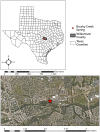Predicting surface abundance of federally threatened Jollyville Plateau Salamanders (Eurycea tonkawae) to inform management activities at a highly modified urban spring
- PMID: 35529492
- PMCID: PMC9070359
- DOI: 10.7717/peerj.13359
Predicting surface abundance of federally threatened Jollyville Plateau Salamanders (Eurycea tonkawae) to inform management activities at a highly modified urban spring
Abstract
Urban expansion has contributed to the loss of habitat for range restricted species across the globe. Managing wildlife populations within these urban settings presents the challenge of balancing human and wildlife needs. Jollyville Plateau Salamanders (Eurycea tonkawae) are a range restricted, federally threatened, species of neotenic brook salamander endemic to central Texas. Almost the entire geographic range of E. tonkawae is embedded in the Austin, Cedar Park, and Round Rock metropolitan areas of Travis and Williamson counties, Texas. Among E. tonkawae occupied sites, Brushy Creek Spring has experienced some of the most extensive anthropogenic disturbance. Today the site consists of small groundwater outlets that emerge in the seams within a concrete culvert underlying a highway. Salamanders persist within this system though they are rarely detected. Here, we model the occurrence of salamanders within the surface habitat of Brushy Creek Spring using generalized linear models. In the absence of available data regarding the amount of water that is discharged from the spring, we use accumulated rainfall as a proxy for discharge to estimate salamander abundance. Additionally, we present evidence of reproduction, recruitment, and subterranean movement by E. tonkawae throughout this site. Infrastructure maintenance is inevitable at Brushy Creek Spring. We intend for our results to inform when maintenance should occur, i.e., during environmental conditions when salamanders are less likely to be observed in the surface habitat, to avoid unnecessary impacts to this federally threatened species.
Keywords: Abundance; Conservation; Edwards aquifer; Habitat; Management; Salamander; Spring; Threatened species; Urbanization.
© 2022 Adcock et al.
Conflict of interest statement
The authors declare that they have no competing interests.
Figures






Similar articles
-
Development and validation of an environmental DNA assay to detect federally threatened groundwater salamanders in central Texas.PLoS One. 2023 Jul 10;18(7):e0288282. doi: 10.1371/journal.pone.0288282. eCollection 2023. PLoS One. 2023. PMID: 37428788 Free PMC article.
-
Spatial Variation in Abundance Parameters of a Federally Threatened Groundwater Salamander Within and Among Central Texas Headwater Creeks.Ecol Evol. 2025 Jun 9;15(6):e71572. doi: 10.1002/ece3.71572. eCollection 2025 Jun. Ecol Evol. 2025. PMID: 40491540 Free PMC article.
-
Movement, demographics, and occupancy dynamics of a federally-threatened salamander: evaluating the adequacy of critical habitat.PeerJ. 2016 Mar 15;4:e1817. doi: 10.7717/peerj.1817. eCollection 2016. PeerJ. 2016. PMID: 26998413 Free PMC article.
-
Detection of Batrachochytrium dendrobatidis in endemic salamander species from central Texas.Ecohealth. 2009 Mar;6(1):20-6. doi: 10.1007/s10393-009-0229-x. Epub 2009 May 8. Ecohealth. 2009. PMID: 19424755
-
Sustenance of Himalayan springs in an emerging water crisis.Environ Monit Assess. 2022 Jan 12;194(2):87. doi: 10.1007/s10661-021-09731-6. Environ Monit Assess. 2022. PMID: 35020087 Review.
Cited by
-
Development and validation of an environmental DNA assay to detect federally threatened groundwater salamanders in central Texas.PLoS One. 2023 Jul 10;18(7):e0288282. doi: 10.1371/journal.pone.0288282. eCollection 2023. PLoS One. 2023. PMID: 37428788 Free PMC article.
References
-
- Adcock ZC, MacLaren AR, Bendik NF, Jones RM, Llewellyn A, Sparks K, White K., IV New occurrence records for Eurycea tonkawae Chippindale, Price, Wiens & Hillis, 2000 (Caudata, Plethodontidae) from an urbanized watershed in Travis County, Texas USA. Check List. 2020;16:1017–1023. doi: 10.15560/16.4.1017. - DOI
-
- Anderson JT, Ward RL, Petty JT, Kite JS, Strager MP. Culvert effects on stream and stream-side salamander habitats. International Journal of Environmental Science and Development. 2014;5(3):274–281. doi: 10.7763/IJESD.2014.V5.491. - DOI
-
- Aronson MFJ, Lepczyk CA, Evans KL, Goddard MA, Lerman SB, MacIvor JS, Nilon CH, Vargo T. Biodiversity in the city: key challenges for urban green space management. Frontiers in Ecology and the Environment. 2017;15(4):189–196. doi: 10.1002/fee.1480. - DOI
-
- Baker JK. Distribution of and key to the neotenic Eurycea of Texas. The Southwestern Naturalist. 1961;6(1):27–32. doi: 10.2307/3669365. - DOI
Publication types
MeSH terms
LinkOut - more resources
Full Text Sources

